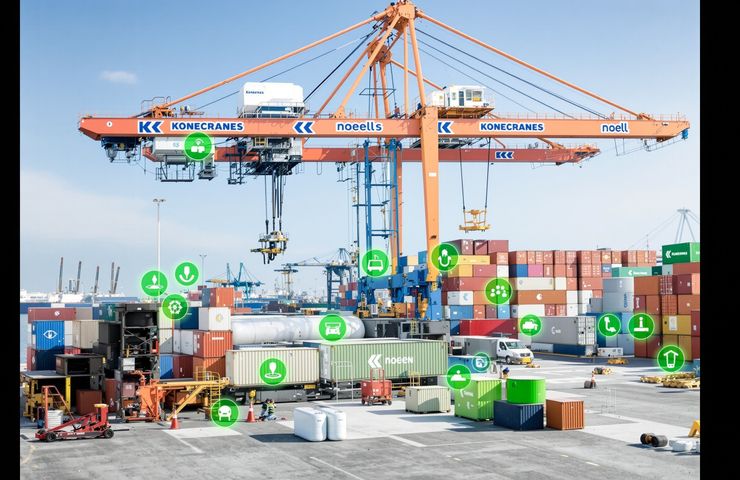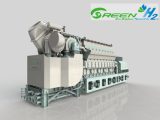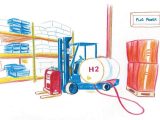
Hydrogen Straddle Carrier Breakthrough: Konecranes Unveils Zero-Emission Heavy-Lifter
October 24, 2025Ever wondered what it takes to ditch diesel fumes from the world’s busiest ports? Picture a machine so clean it runs on hydrogen and only exhales pure water vapor. At TOC Americas 2025 in Panama City on 14/10/2025, Konecranes stole the spotlight by rolling out its Noell Hydrogen Fuel Cell Straddle Carrier. And no, this isn’t some far-off prototype—it’s beefy, it’s ready, and it’s designed for heavy lifting without the drama.
But let’s be real: Konecranes didn’t just parachute in yesterday. Founded in Finland back in ’94, these folks now number around 16,600 pros across 50-plus countries, racking up EUR 4.0 billion in sales last year. They’ve been the go-to for electrified cranes, smart lifting gear and port automation. Their mission? “Ecolifting” everything to zero emissions. That hydrogen straddle carrier is their boldest shot yet at cracking the code for sustainable port operations.
So, What’s the Big Deal?
Ports are bustling, dusty jungles of machinery, where diesel engines growl day and night. They guzzle millions of litres of fuel and cough out nitrogen oxides, particulate matter and greenhouse gases. That’s a problem for the air, the health of dockworkers and the big-picture climate targets. Meanwhile, container traffic just keeps climbing, and regulators are cranking up the emissions rules. The industry needed a heavyweight contender to keep pace without choking on pollution.
Traditional straddle carriers can weigh up to 90 tonnes and stack containers five-high. They deliver jaw-dropping power, but that strength comes with a throat of black smoke and a maintenance bill that never quits. Electric versions sidestep the soot but hit a wall on range and charging downtime. Neither diesel nor batteries solved the ultimate performance puzzle—until hydrogen swooped in.
Fuel cells had been moonlighting in forklifts and small tuggers, but fitting that magic into a near-100-tonne hauler was a different ballgame. After years of trial and error on smaller rigs, Konecranes finally smashed the barrier—ushering hydrogen tech into the big leagues of port gear.
The Magic Ingredient?
Behind the curtains, the secret sauce is simple: liquid hydrogen tanks feeding an array of hydrogen fuel cells. Inside each cell, hydrogen meets oxygen over a membrane, sparking electricity, a bit of heat—and just water. That juice hits electric motors with the same torque and acceleration you’d expect from diesel, minus the shove of smoke. And topping up? Under 10 minutes, almost like pulling into a diesel bay—none of those marathon charging sessions.
Want more flexibility? The real game-changer is the modular power platform. Swap in a diesel-hybrid pack today, pop in battery modules tomorrow, or slide in hydrogen cells next week. At the TOC show, Konecranes demoed a module swap within a standard service window—no heavy refit, no endless downtime. It’s the ultimate in plug-and-play, future-proof gear and zero-emission port equipment.
Real-World Rollout
Lab wins are nice, but the heat’s on in the real world. Over in Hamburg, Hamburger Hafen und Logistik AG (HHLA) set up a hydrogen test site on its container grounds. There, the hydrogen straddle carrier handled daily stacks and moves at diesel-like speeds. Operators raved about the whisper-quiet cabin and instant power delivery—no more ear-splitting revs on the late shift.
Safety? Top of mind. Those hydrogen tanks nestle behind reinforced panels, and the refuelling rigs come with leak detectors and automatic shut-offs. Thomas Gylling from Konecranes pointed out that all fueling trials stuck to the strictest industry codes, giving terminal bosses solid confidence to pull the trigger on pilots.
Behind the Scenes
Why Panama City? It sits at the crossroads of global trade—right by the Panama Canal, where shipments move between oceans and continents. TOC Americas draws port operators, terminal managers and supply-chain planners from every corner of the globe. Dropping a hydrogen straddle carrier here sends a clear message: zero-emission port equipment is no longer a distant dream—it’s ready for prime time.
According to Gylling, “We chose a venue where major players actually plan their investments. You test a demo unit, build out your refuelling network, then convert your fleet step by step. It’s a down-to-earth roadmap to slashing emissions.”
Why It Matters
Dumping diesel for hydrogen nukes tailpipe emissions, so air on and around the docks gets cleaner. That translates to healthier workers and neighbors. Noise levels plummet too—a calm, less frantic work vibe. And thanks to the modular power platform, operators dodge technology lock-in: switch from diesel to battery or hydrogen as the fuel-market winds shift.
Once green hydrogen production scales up and costs drop, the total cost of ownership could rival traditional diesel rigs. Fuel cells have fewer moving parts than a diesel engine, slashing maintenance headaches. Ports can tap carbon credits and clean-energy incentives, and let’s face it, being a sustainability leader attracts investment, talent and goodwill.
Sure, hurdles remain. Building a hydrogen refuelling network takes capex and careful planning. Staff need safety training, and the hydrogen supply chain is still evolving. But the HHLA pilots and the Panama demo prove you can bust through these barriers with the right partners.
Looking Ahead
Konecranes is gearing up to deploy more demo units across North America, Southeast Asia and the Middle East—regions that can’t wait for cleaner port solutions. By 2026, they aim to offer a full lineup of all-electric, hybrid and hydrogen-powered cranes, carriers and forklifts.
Beyond straddle carriers, that same modular approach could juice up ship-to-shore cranes, rail-mounted gantries and automated guided vehicles. Standardizing power modules simplifies inventory, training and maintenance for ports juggling mixed fleets.
Keep an eye on regulators too. As pilots prove hydrogen’s worth, incentives and mandates will follow. Tax breaks for zero-emission fleets, ramped-up R&D in green hydrogen, faster distribution networks—it’s all on the horizon. Major shipping lines and terminal operators are watching with interest, ready to invest once the policy frameworks lock in. The shift won’t happen overnight, but the momentum is undeniable.
Final Shot
This isn’t just another crane. The Noell Hydrogen Fuel Cell Straddle Carrier is a beacon for sustainable port operations. Zero emissions, zero performance compromises, and a future-proof path to cleaner, quieter, smarter ports. The next generation of zero-emission port equipment has arrived—and it’s fueled by hydrogen.



 With over 15 years of reporting hydrogen news, we are your premier source for the latest updates and insights in hydrogen and renewable energy.
With over 15 years of reporting hydrogen news, we are your premier source for the latest updates and insights in hydrogen and renewable energy.